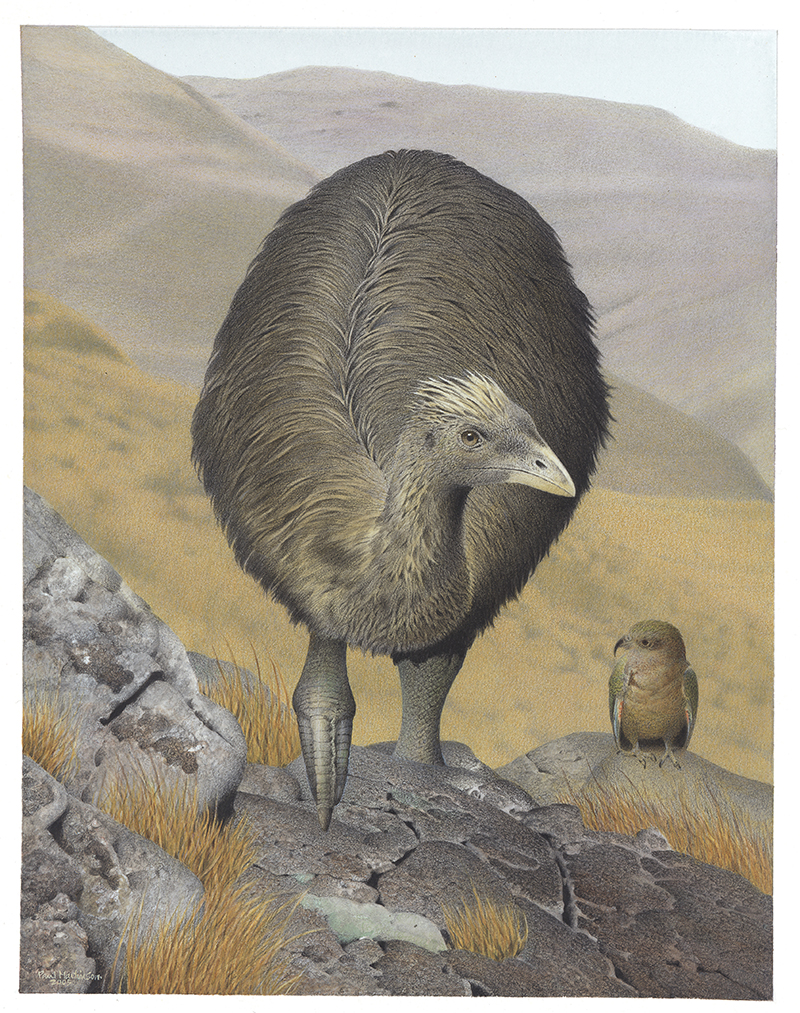Pachyornis australis Oliver, 1949:70
Crested moa, Moa Koukou (Māori)
Taxonomy & Nomenclature
Synonym/s: Mesopteryx sp. β Parker, 1895: Trans. Zool. Soc. London 13(11): 378.; Pachyornis (Pachyornis) australis Oliver, 1949: Dom. Mus. Bull. 15: 59.; Pachyornis elephantopus; Cracraft 1976, Smithsonian Contrib. Paleobiology 27: 196. Not Dinornis elephantopus Owen, 1856.
Conservation Status
Extinct
Last record: "564±26 yr BP (544–508 cal yr BP; 95.4% AD 1396–1442)" (Rawlence & Cooper, 2013)
Distribution
South Island, New Zealand
Biology & Ecology
Hypodigm
Holotype: NMNZ S.26 (skull + 20 vertebrae)
Media

Above: Crested Moa. Pachyornis australis. From the series: Extinct Birds of New Zealand., 2005, Masterton, by Paul Martinson. Purchased 2006. © Te Papa. CC BY-NC-ND 4.0. Te Papa (2006-0010-1/19)
References
Original scientific description:
Oliver, W. R. B. (1949). The moas of New Zealand and Australia. Wellington: Dominion Museum Bulletin 15. 206 pp.
Other references:
Attard, M. R. G., Wilson, L. A. B., Worthy, T. H., Scofield, P., Johnston, P., Parr, W. C. H. and Wroe, S. (2016). Moa diet fits the bill: virtual reconstruction incorporating mummified remains and prediction of biomechanical performance in avian giants. Proc. R. Soc. B 283: 20152043.
Baker, Allan J. et al. (2005). Reconstructing the tempo and mode of evolution in an extinct clade of birds with ancient DNA: The giant moas of New Zealand. PNAS 102(23): 8257-8262.
Carden, Deborah. (2006). Collection of a Crested moa. ACKMA Journal 64: 2 pp.
Checklist Committee (OSNZ). (2010). Checklist of the Birds of New Zealand, Norfolk and Macquarie Islands, and the Ross Dependency, Antarctica (4th ed.). Ornithological Society of New Zealand & Te Papa Press, Wellington. [p. 14]
Checklist Committee (OSNZ). (2022). Checklist of the Birds of New Zealand (5th edition). Ornithological Society of New Zealand Occasional Publication No. 1. Wellington: Ornithological Society of New Zealand. [p. 16]
Holdaway, Richard N., Worthy, Trevor H. and Tennyson, Alan J. D. (2001). A working list of breeding bird species of the New Zealand region at first human contact. New Zealand Journal of Zoology 28: 119-187.
Hume, Julian Pender and Walters, Michael. (2012). Extinct Birds. London: T & AD Poyser.
Rawlence, N. J. and Cooper, A. (2013). Youngest reported radio-carbon age of a moa (Aves: Dinornithiformes) dated from a natural site in New Zealand. Journal of the Royal Society of New Zealand 43(2): 100-107. [Abstract]
Rawlence, N. J. et al. (2012). The effect of climate and environmental change on the megafaunal moa of New Zealand in the absence of humans. Quaternary Science Reviews 50: 141-153. [Abstract]
Robertson, H. A., Baird, K. A., Elliott, G. P., Hitchmough, R. A., McArthur, N. J., Makan, T. D., Miskelly, Colin M., O’Donnell, C. F. J., Sagar, P. M., Scofield, R. P., Taylor, G. A. and Michel, P. (2021). Conservation status of birds in Aotearoa New Zealand, 2021. New Zealand Threat Classification Series 36. Department of Conservation, Wellington. 43 pp.
Hugh Robertson, John Dowding, Graeme Elliott, Rod Hitchmough, Colin Miskelly, Colin O’Donnell, Ralph Powlesland, Paul Sagar, Paul Scofield, Graeme Taylor. (2013). Conservation status of New Zealand birds, 2012. New Zealand Threat Classification Series 4. 22 pp.
Sayol, Ferran, Steinbauer, Manuel J., Blackburn, Tim M., Antonelli, Alexandre and Faurby, Søren. (2020). Anthropogenic extinctions conceal widespread evolution of flightlessness in birds. Science Advances 6(49): eabb6095. https://doi.org/10.1126/sciadv.abb6095 [Supplementary Material (Data File S1)]
Tennyson, Alan J. D. and Bartle, J. A. (2008). Catalogue of type specimens of birds in the Museum of New Zealand Te Papa Tongarewa. Tuhinga 19: 185-207.
Tennyson AJD and Martinson P (2006) Extinct Birds of New Zealand. Te Papa Press, Wellington.
Tyrberg, Tommy. (2009). Holocene avian extinctions, pp. 63-106. In: Turvey, Samuel T. (ed.). Holocene Extinctions. Oxford, UK & New York, USA: Oxford University Press. xii + 352 pp.
Worthy, Trevor H. (1989a). Moas of the subalpine zone. Notornis 36: 191-196.
Worthy, Trevor H. (1989b). Validation of Pachyornis australis Oliver (Aves: Dinornithiformes), a medium sized moa from the South Island New Zealand. New Zealand Journal of Geology and Geophysics 32: 255-266.
Worthy, Trevor H. (1990). An analysis of the distribution and relative abundance of moa species (Aves: Dinornithiformes). New Zealand Journal of Zoology 17: 213-241.
Worthy, Trevor H. (1991). An overview of the taxonomy, fossil history, biology and extinction of moas. Proceedings of the Twentieth International Ornithologists Congress, Symposium 6: 555-562.
Worthy, Trevor H. (1993). Fossils of Honeycomb Hill. Museum of New Zealand, Te Papa Tongarewa, Wellington. 56 pp.
Worthy, Trevor H. (1994). Late Quaternary changes in the moa fauna (Aves; Dinornithiformes) on the West Coast of the South Island, New Zealand. Rec. S. Aust. Mus. 27(2): 125-134.
Worthy, Trevor H. (1997). Fossil deposits in the Hodges Creek Cave System, on the northern foothills of Mt Arthur, Nelson, South Island, New Zealand. Notornis 44(2): 111-124.
Worthy, Trevor H. (1998). Quaternary fossil faunas of Otago, South Island, New Zealand. Journal of the Royal Society of New Zealand 28(3): 421-521. https://doi.org/10.1080/03014223.1998.9517573 [p. 451]
Worthy, Trevor H. and Holdaway, Richard N. (1993). Quaternary fossil faunas from caves in the Punakaiki area, West Coast, South Island, New Zealand. Journal of the Royal Society of New Zealand 23(3): 147-254.
Worthy TH and Holdaway RN (2002) The Lost World of the Moa. Indiana University Press, Bloomington.
